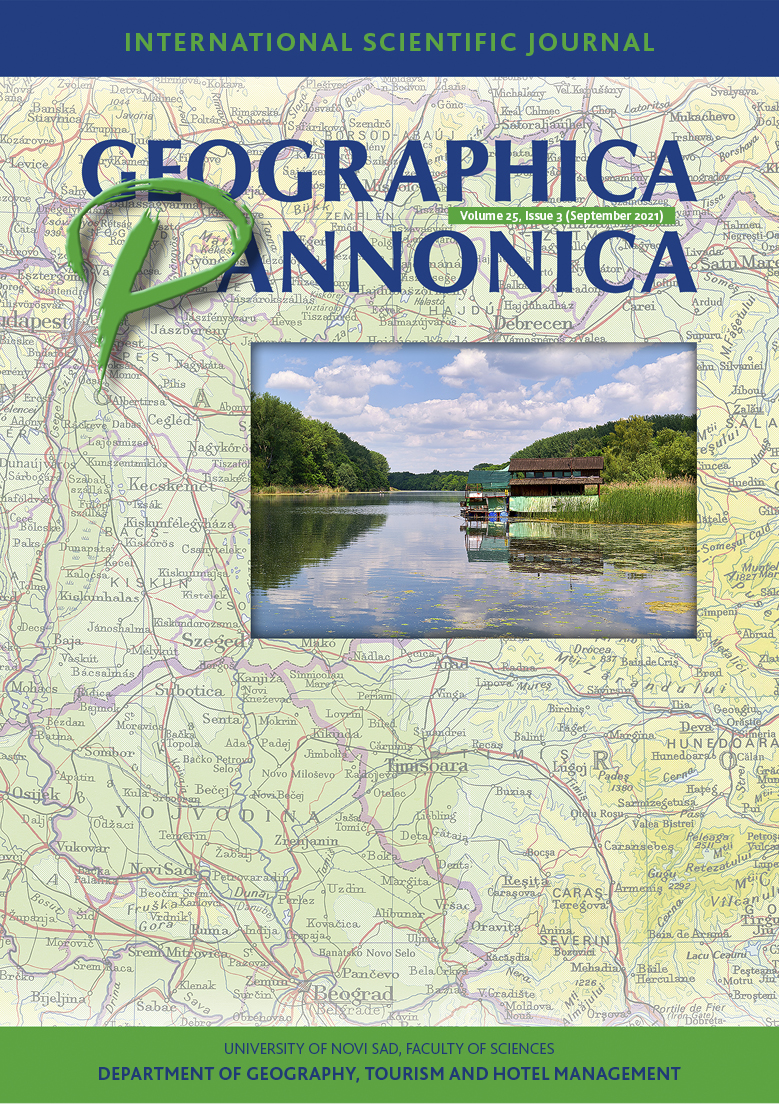New landscape conceptualization as a guideline for spatial development: a case study from Serbian spatial planning practice
Abstract
This work is focused on clarification of the basic principles for the establishment of an innovative approach in the field of landscape research through its application in spatial planning documents in Serbia. The question is posed how the practice of considering landscape character, as a reflection of spatial change dynamics, could direct new spatial arrangements based on the development of strategic spatial planning documents. The research is based on analysis undertaken during the elaboration of the “Spatial plan for a special-purpose area The Cultural Landscape of Sremski Karlovci”. The approach taken in the applied conceptual framework is to view landscape character and its functions as the starting point for guiding dynamic interactions in spatial change and it is opposed to the traditional approach of land-use decision making. This work provides the elements for creating a different conceptual framework for spatial planning in Serbia based on landscape conceptualization and as an application model of the European Landscape Convention.
References
Ahern, J. (2011). From fail-safe to safe-to-fail: Sustainability and resilience in the new urban world. Landscape and Urban Planning, 100(4), 341-343.
Antrop, M (2000). Background concepts for integrated landscape analysis. Agriculture Ecosystems & Environment, 77(1-2), 17-28.
Antrop, M. (2006a). From holistic landscape synthesis to transdisciplinary landscape management. In B. Tress, G. Tres, G. Fry, P.Opdam (Eds.). From Landscape Research to Landscape Planning: Aspects of Integration, Education and Application (Vol. 12, pp. 27-50). Dordrecht, NL: Springer.
Antrop, М. (2006b). Sustainable landscapes: contradiction, fiction or utopia?. Landscape and Urban Planning, 75(3-4), 187–197.
Antrop, M., & Van Eetvelde, V. (2008). Mechanisms in recent landscape transformation. WIT Transaction on the Built Environment, 100, 183-192.
Corner, J. (2006). Terra Fluxus, In C.Waldheim (Ed.), The Landscape Urbanism Reader, ; New York, NYC: Princeton Architectural Press, pp. 21-33.
Council of Europe (2000). European Landscape Convention and Explanatory Report. Strasbourg. Council of Europe General directorate of Education, Culture, Sport and Youth and Environment, 200.0, Landscape ConventionT-LAND 06e.
De Montis, A. (2014). Impacts of the European Landscape Convention on national planning systems: A comparative investigation of six case studies. Landscape and Urban Planning, 124, 53-65.
Giddens, A. (1984). The Constitution of Society: Outline of the Theory of Structuration. Berkeley and Los Angeles, CA: University of California press.
Koolhaas, R. (1995). What Ever Happened to Urbanism?. J. Sigler (Ed.). S,M,L,XL: O.M.A (pp. 959-971). New York, NYC: The Monicelli Press.
Mapire. (2018, February 22). The historical Map Portal, Austrian State Archives (Österreichisches Staatsarchiv). Retreived from http://mapire.eu/en/.
Mayer, E., (1997). The Expanded Field of Landscape Architecture. In G. F. Thompson, F. R. Steiner (Eds). Ecological Design and Planning. New York, NYC: John Willey & Sons. INC. pp. 45-79.
Pihler, V., Vasiljevic, T.Z., & Duncic, D. (2013). Water management, environmental protection and spatial planning reconciliation: "Accommodating" the Danube and the Tisa river in Serbia. Spatium, 29, 49-52.
Roe, M., Jones, C., & Mell,I.C. (2008). Final Report A Study for Natural: Research to Support the Implementation of the European Landscape Convention in England. England. Contract No. PYT02/10/1.16. Retrieved from https://www.academia.edu/download/8645595/elc-ne-research-march2008_tcm6-23598.pdf
Selman, P. (2006). Planning at the Landscape scale; London, UK: Routledge.
Selman, P. (2010). Landscape planning - preservation, conservation and sustainable development. Town Planning Review, 81(4). 381-406.
Semančíková, E., Dvočáková, Z., & Líšková, V. (2007). How does strategic planning deal with spatial landscape problems? Proceedings of the Man in the landscape across frontiers: Landscape and land use change in Central European border regions. Conference Proceedings of the IGU/LUCC Central Europe Conference 2007. Charles University in Prague, Czech Republic: Faculty of Science pp.153-163.
Steinitz, C. (2005). From Project to Global: on Landscape Planning and Scale. Landscape Review, 9(2). 117-127.
Swanwick, C., Herlin, I. S., & Fairclough, G., (2002). Landscape Character Assessment, Guidelines for England and Scotland. Edinburgh, UK: The Countryside Agency, Cheltenham and Scottish Natural Heritage.
The Spatial Plan of the Republic of Serbia 2010-2020. Belgrade, RS: Official gazette of Republic of Serbia“, No. 88/10. Retrieved from: http://www.rapp.gov.rs/en-GB/content/cid310/
Spatial Plan for the Special Purpose Area “The Cultural Landscape of Sremski Karlovci”, 2017, Urban and Spatial Planning Institute of Vojvodina, Novi Sad, APV: Official gazette of APV No 57/2017 Retrieved from: http://www.ekourbapv.vojvodina.gov.rs/wp-content/uploads/2018/08/Odluka-i-Plan-iz-Sl-lista-1.pdf)
Van den Broeck, J. (2004). Strategic Structure Planning. A. Loeckx, K. Shannon, R. Tuts, H. Verschure (Eds.). Urban Trialogues: Visions, Projects, Co-productions. Localising Agenda 21. Nairobi, Kenya: UNCHS (United Nations Center for Human Settlements), pp. 168-184
Van Eetvelde, V., & Antrop, M. (2007). Proceedings of the 18th International Annual ECLAS Conference 2007: Landscape character beyond landscape typologies. Methodological issues in trans-regional integration in Belgium. Belgrade, RS, pp. 229-239.
Vasiljevic, N. (2018). Landscape Planning: Theories and methodologies, Belgrade, Serbia: University of Belgrade - Faculty of Forestry.

